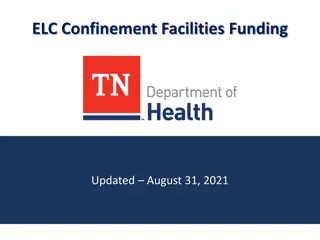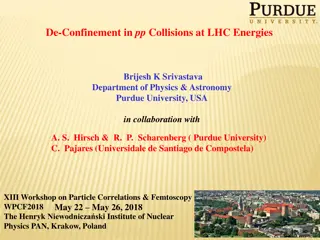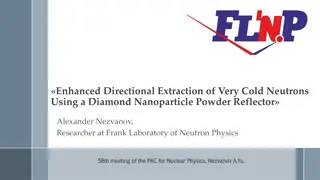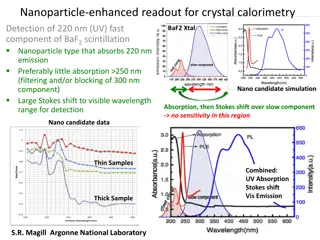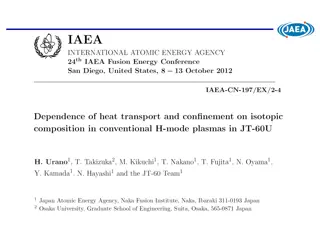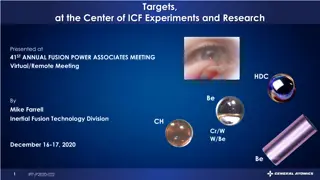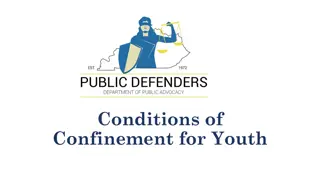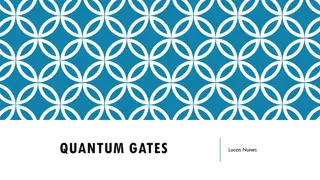Advances in Nanoparticle-Enhanced Photosensors for UV Light Detection and Quantum Confinement Research
Nanoparticle-enhanced photosensors are being developed by Steve Magill at Argonne National Laboratory for UV light detection, utilizing quantum confinement to enhance electronic and optical properties. Quantum confinement creates discrete energy levels in nanoparticles smaller than the electron wavelength, leading to unique tunability and absorption properties. Recent developments at ANL and collaborations with CytoViva, Wei Chen at UTA, and other partners focus on nanoparticle diagnostics, crystal readout tests, and technology commercialization for applications such as greenhouse coatings and wavelength shifters for gases like Argon and Xenon.
Download Presentation

Please find below an Image/Link to download the presentation.
The content on the website is provided AS IS for your information and personal use only. It may not be sold, licensed, or shared on other websites without obtaining consent from the author.If you encounter any issues during the download, it is possible that the publisher has removed the file from their server.
You are allowed to download the files provided on this website for personal or commercial use, subject to the condition that they are used lawfully. All files are the property of their respective owners.
The content on the website is provided AS IS for your information and personal use only. It may not be sold, licensed, or shared on other websites without obtaining consent from the author.
E N D
Presentation Transcript
Nanoparticle-enhanced photosensors for UV light detection Steve Magill Argonne National Laboratory 9/14/2024 1
Motivation 9/14/2024 2
Quantum Confinement If the size of the nanoparticle is smaller than the electron wavelength : -> Quantum Confinement condition Larger energy gap Splitting of energy levels Strong transitions -> Tunable electronic and optical properties if nanoparticle size typically <10 nm Occurs on atomic/molecular level > higher intensity, efficiency than bulk material Energy level splitting vs size (a); ab* is exciton Bohr radius Happens in the Sun - quantum confinement dominates -> many energy level splittings -> continuous to make white light
Nanoparticles - Quantum Confinement Quantum Confinement changes material properties when particle size < electron wavelength Eg increases with decreasing particle size -> UV photon absorption Discrete energy levels form at the band-edges Stokes Shift is difference between absorption and emission wavelength Emission wavelength decreases with decreasing size -> tunability 9/14/2024 4
Terminology of nanoparticle dimensionality o Dimensions shown as rectangular solids o Electron wavelength (Exciton Bohr diameter) represented by the sphere o Plots show Density of States (DOS) vs Energy o Dimensionality 3D is bulk material -> 0D is Quantum Dot
Recent Developments at ANL + Collaborators Scientific Reports article July, 2018 Contact: CytoViva, Inc. (measurement instrumentation) currently working closely with Wei Chen at UTA on methods/devices for nanoparticle diagnostics Future publication of nanoparticle candidate for BaF2 crystal readout test optimized cookie with monochromator, spectrophotometer Patented candidate for Mu2e calorimeter upgrade (BaF2 UV readout) Technology Commercialization Fund: passed 1st round of pre-proposal full proposal due Dec 12; strong group behind proposal ANLHEP - intial testing, characterization ANLAMD atomic layer deposition techniques for film production ANLNST - timing, size, etc. studies of nano candidates UTA - selection/production of nano candidates in many forms Solgro, Inc. - coatings for greenhouse panels, plant growth testing provider of non-Federal matching funds for full proposal Current SBIR with CapSym, Inc. - Nanoparticle wavelength shifters for Argon, Xenon
Testing Tools at ANL Low wavelength filter-based vacuum/N2 atmosphere testing device (under development) PYTHON macros to calculate relevant quantities electron wavelength, fermi energy, band gap enhancement, etc. predict whether a candidate will show QC effects used in our SR article to successfully explain observations Scanning monochromator good down to ~200 nm, need N2 environment to eliminate fluctuations down to ~160 nm (window limit) Spectrophotometer try Ocean instrument in our next publication ANLNST (NanoSciende and Technology Division) - measurements of timing of Stokes Shift, other nano diagnostics - Simulation code to predict nanoparticle properties
Initial Nanoparticle sample tests Si nanoparticle coating on plastic film (U of I partner) Published result: JINST 10 05008 (2015) Enhanced response: 250 nm < < 300 nm Nanoparticles deposited on clear plastic tape (UTA partner) Published result: SR 8:10515 (2018) Enhanced response for samples: 200 nm < < 250 nm 9/14/2024 8
BaF2 Crystal Readout Mu2e Upgrade Fast components (195, 224 nm) - Decay time ~1 ns Slow component (250 -> 400 nm) - Decay time ~650 ns SiPM peak sensitivity (425 nm) Absorption, then Stokes shift over slow component to sensor no sensitivity for slow component! 9/14/2024 9
Absorption/emission of nanoparticle candidate Absorption: strong < 250 nm weak > 250 nm Emission: 300 nm < < 600 nm Stokes Shift: ~200 nm peak-to-peak 9/14/2024 10
Nanoparticle candidate for BaF2 Readout Little absorption for wavelengths >250 nm 195, 224 nm emission of BaF2 absorption peak of nanoparticle Overlap of slow component and nanoparticle emission: 1) wave-shift to longer wavelength, or 2) resin coating on the SiPM 9/14/2024 11
Nanoparticle Response Tested a nanoparticle sample made at UTA by mixing nanoparticles in UV-transparent grease (DOW-Corning) Compare blue, purple it appears that passing through more nanoparticles helps small reduction in the peak at 220 nm and a larger reduction in the signal > 245 nm. Nano/grease+ Thin sample -> determine the amount of nanoparticles in the grease by optimizing the 220/300 ratio for maximum rejection of light >250 nm. Nano/grease++ -> Ratio of 220/300 for purple (thick) sample is ~2/1 Thick sample 9/14/2024 12
A different nanoparticle candidate 1 UTA nanoparticles deposited directly on the resin (face) of the SiPM 1X1 MPPC Signal (nAmps) -1 10 -2 10 -3 10 Uncoated MPPC Coated MPPC Enhanced response of coated SiPM seen in the wavelength range from 200 nm 240 nm compared to uncoated sensor -4 10 200 225 250 275 300 325 350 375 400 Wavelength (nm) Ratio (Coated/Uncoated) 10 Without any optimization, ratio of coated to uncoated in the 200 240 nm range is ~factor of 10 greater than in the region > 250 nm! 1 200 225 250 275 300 325 350 375 400 Wavelength (nm) We have tested at least 2 nanoparticle candidates which show sensitivity in the desired wavelength range and, in addition, much reduced sensitivity without the need for 9/14/2024 additional filters in the wavelength range > 250 nm 13
Plans for BaF2 220 nm Readout Optimize thickness, nanoparticle concentration in DOW- Corning grease for best signal to noise (220 nm / 300 nm) ratio using monochromator Test this on a BaF2 crystal with muons Find a binder that can contain nanoparticles at the optimal concentration and thickness that makes a soft cookie for placement between a crystal and a sensor (SiPM) Siloxane epoxy (same properties as DOW-Corning grease?) 3M hardener + DOW grease + nanoparticles -> soft cookie for crystal face recently accomplished Or, a hard, permanent coating for a crystal face Produce nanoparticle/sensor combination for Mu2e BaF2 Calorimeter 9/14/2024 14
Motivation: Homogeneous, Dual-Readout Calorimetry * * Nanoparticle-infused cookie on crystal sides!
S/E C/S
Future Pixel APA for DUNE (4th detector) Nanoparticle idea for photon detection on a pixel APA Need plane with 2D pixels (metal charge collector) and photon sensors Idea photon sensors form the plane with charge collection pixels isolated within the photon sensors Pixel plane is made of a substrate material with nanoplatelets deposited on the substrate, readout on the back side (outside of TPC) Nanoplatelets absorb VUV photons, generate electrons direct conversion of photons to current (possibly no separate photosensor) Current SBIR to identify nano candidates sensitive to 128 nm and 175 nm > form into nanoplatelets -> direct signal Keep in mind doping Argon with hundreds of ppm Xenon converts all 128 nm light to 175 nm may already have suitable candidates to start incorporating into nanoplatelets (to be tested in pDuNE)
Qpix plane inside Field Cage Nanoplatelet layer for photon detection Pixel pitch Nanoplatelets UV absorption to electron current (ANL NST Division) Pixels for charge collection surrounded by layer of nanoparticles UV -> Visible -> photosensor -> readout Or, possibly UV -> electron current -> readout
ANL NST - Nanoplatelets Alternative form for readout of crystal: - Nanoplatelet (1-dimension smaller than e) deposited on crystal surface - Amplification of signal when lateral size increases (multiple signal response shows up at 0 ns time delay) - Collaboration between CNM and ANLHEP (joint LDRD proposal submitted) Work at ANL Center for Nanoscale Materials Published: ACS Nano 2017, 11, 9119-9127 9/14/2024 24
Potential? Nanosensors,? Applications,? Customers? Detector? App? Absorbed? ? (nm)? Emitted? ? (nm)? Nano? Candidates? Customers? Argon? Coating? 125? 425? CdTe? HEP(DUNE,? SBN)? Xenon? Coating? 178? 425? CdTe? HEP,? NP(Dark? Matter,? 0 )? Water? Coating? 125-300? 425? CdTe,? LaF3:Ce? HEP(ANNIE)? BaF2? Xstal? Cookie,? Surface? 220? 425? LaYO,? CuCy,? ZnS:Mn,? ZnS:Mn-Eu,? CdTe? HEP(Mu2e)? PbF2? Xstal? Cookie,? Surface? 200-300? 425? Si,? LaYO,? LaF3:Ce,? CdTe? HEP,? NP(g-2,? DRCal)? CsI,? CeF3,? CeBr3,? LaCl3,? LaBr3? Xstals? Cookie,? Surface? 300-371? 425? LaF3:Ce? Medical? Plastic? Lens? Infusion,? Coating? 300-400? 425-550? LaF3:Ce? Night? Vision,? Defense? Window? Glass? Infusion,? Coating? 300-400? 425-550? LaF3:Ce? Homes,? Businesses,? Greenhouses?
Some other interesting Apps UV Night Vision Use reflected UV light in 300-400 nm range to enhance vision in low light conditions UV tag identifiers Enhanced plant growth Match light in greenhouses to the dual absorption peaks of chlorophyll Nanoparticle spray for crops in fields! Pending TCF (DOE) proposal Window glass lighting Nanoparticle-infused window glass lights interior spaces No power required Planned tests at ANL glass shop
Nanoparticle-enhanced Night Vision From ScienceDaily . . . and Deer Bats Scan The Rainforest With UV-Eyes Bats from Central and South America that live on nectar from flowers can see ultraviolet light (Nature, 9 October 2003). There is little light at night. But compared to daylight, the colour spectrum is shifted towards short, UV-wavelengths. Interestingly, bats achieve an absorption efficiency in the UV bandwidth of nearly 50 percent of their photoreceptors major peak of absorbance (alpha-band). This is nearly five times the value expected from in-vitro measurements of beta-band absorption in rhodopsin molecules. Whether this indicates a novel mechanism for light perception in the bats eye that is still unkown for mammals remains open. -> High efficiency for UV absorption is a characteristic of quantum confinement in nanoparticles Bat eye rods are coated with nanoparticles!? Ratio N%/0% LaF3:Ce . . . and now Us! LaF3:Ce nanoparticles in transparent polycarbonate buttons (contacts) Enhancement for 10% LaF3:Ce: 230 nm < < 390 nm 27 Wavelength (nm)
Solgro, Inc. Results Nanoparticle application: Use 2 different nano candidates to convert UV to blue and UV and green to red Nano candidates in plastic film First results show dramatic increase under nano film section! Also Bioelectricity production from plant- based fuel cells! Using other nanoparticle to filter unwanted IR -> lower temp in greenhouse
Nanoparticle candidate for window glass 2.75 Ratio (NP%/0%) 0% NP Enhanced response for 10% concentration of nanoparticle candidate in range 300 400 nm 2.5 2% NP 5% NP 10% NP 2.25 20% NP 30% NP 2 Infuse into window glass, chose nanoparticle size so that emitted wavelength is ~470 nm (peak of solar light spectrum) 1.75 1.5 1.25 1 At least 10% more usable light! more in low light conditions 0.75 200 225 250 275 300 325 350 375 400 Wavelength (nm)





